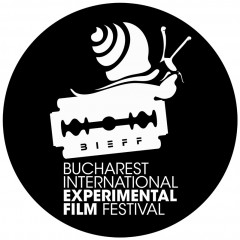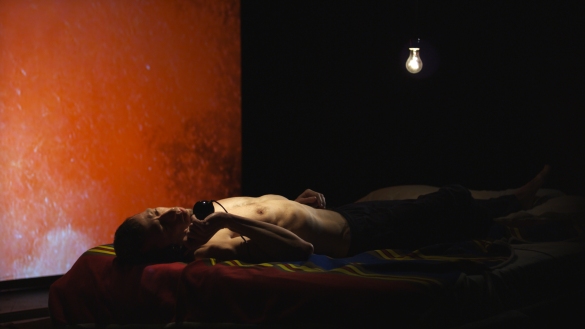Oana Ghera: You were inspired for AS THE FLAMES ROSE by Cocteau’s “La voix humaine”, a monologue written for theater whose theatricality you expose in various ways, from revealing its source (by posing the book on the character’s nightstand) to the expressionist play with the lighting (to name just one of your techniques). Yet, it seems to me, AS THE FLAMES ROSE is also a declaration of love for cinema as a medium, what with all the rear projections and TV footage, for artificial as they may be, still manage to expand the enclosed space of the studio in a deeply cinematic way. Where do you stand regarding the long theorised relation between cinema and theater? Where did the influence of the play end and where did that of cinema begin in your creative process? Or are they intertwined? And also regarding the matter of theatricality, how do you relate to Fassbinder’s work?
JOÃO RUI GUERRA DA MATA: To tell you the truth, the idea for AS THE FLAMES ROSE came from a comics strip that I first created back in the mid 80’s, after the Great Lisbon Fire and long before having read Cocteau’s play or seen Rossellini’s film. When I went back to that story for my first solo film, the proximity with Jean Cocteau was obvious and that’s why I chose to pose Cocteau’s book as a prop on the nightstand. Although the script I wrote is very freely inspired by Cocteau’s beautiful theater play, by no means did I want viewers to think I wasn’t conscious of the subterranean liaisons between the two objects.
There’s a unity of space and time, as in a play, but I tried to make it so that the space of the studio (we’re far from naturalism) was shattered by the multiple projections, both rear and frontal, by cinematic devices such as camera movement, lightning, off-screen space and sound. The film is also a sort of time lapse: from the 80’s when the story is set to now, where the final song transports you – I never wanted to make a period film that attempts to faithfully depict a specific time – as feelings are timeless, cinema should move in the same direction, an acute abstraction of reality that takes you forward while making you look back. Isn’t that the power of Fassbinder’s films still today?
Oana Ghera: I was meaning to ask you about this play with time, especially that anachronism the final song represents.
JOÃO RUI GUERRA DA MATA: The idea to use James Blake’s 2011 “The Wilhelm Scream” was also to refer to the emotional strength of the story I was trying to tell and the feelings expressed in the lyrics of the song, that could perhaps transcend time and place, becoming universal.
Oana Ghera: About this emotional strength. How do you see the actor? I’m asking you this because Cocteau’s monologue, as you know, was also adapted by Roberto Rossellini more than 60 years ago in “L’amore” with Anna Magnani, as the deserted lover, giving the sort of heartbreaking performance suitable for one of the silent films divas. If I remember well, Rossellini even dedicates the film “to the art of Anna Magnani”. Instead, the performance of João Pedro is a rather quiet one, emotional as well, yet subtle, the kind that enhances a natural empathy between spectator and character.
JOÃO RUI GUERRA DA MATA: João Pedro, as an actor, is much closer to the Bressonian “model” than to a “performance actress” as “La Magnani” in the Rossellini film or Ingrid Bergman in Ted Kotcheff’s 1966 TV film. I agree with you when you say that João Pedro’s performance is rather quiet, subtle, yet emotional. That’s what I asked him to do, even though I knew it involved a risk. I’m very proud that AS THE FLAMES ROSE was presented in a Special Screening presentation about Jean Cocteau’s “La voix humaine”, featuring Rossellini’s “Una Voce Umana” with Anna Magnani and Ted Kotcheff’s “The Human Voice” with Ingrid Bergman at the Turin International Film Festival in 2012. It was interesting to compare the different conceptual approaches to a similar subject. There was a film missing though: Vincent Dieutre’s “Ea3 – 3ème exercice d’admiration: Cocteau” with Jacques Nolot.
Oana Ghera: How did you work with João Pedro Rodrigues as an actor? In the way (or maybe not) that Rossellini dedicates his film to Magnani, do you dedicate yours “to João Pedro”?
JOÃO RUI GUERRA DA MATA: João Pedro and I worked very closely as he was very much afraid he wouldn’t remember the lines during the long takes I had in mind when I imagined the découpage of the film. Being a monologue it was a very difficult exercise for him so that he could convey the precise emotional subtlety needed. I dedicated the film to João Pedro because I started working in cinema with him and I feel I learned a lot from our complicity. Also, João Pedro dedicated his first film “O Fantasma” to me… I suppose dedicating my first film to João Pedro was also a way of thanking him for believing I could actually make this film, for accepting to be my actor and for delivering such a brilliant performance.
Oana Ghera: And talking about your collaborations. It strikes me to see how different this film is from your collaborations with João Pedro Rodrigues. You filmed it in a studio, you used an expressionist scheme of lightning, you had a much more visible dramatic structure and so on. Still, even in this enclosed artificial space you introduce documentary images. Why? Or why did you choose to go inside a studio in the first place and break with the film essay convention you used in your previous work?
JOÃO RUI GUERRA DA MATA: As you know, I’m mainly an art director / production designer and it was always my dream to shoot in a studio. A film shot on location recreates the reality out of real life and I wanted to film in a totally controlled environment where I could recreate reality out of artificiality and could control that “unreality” to create the most real time and place where this very emotional, personal, yet universal story could be developed. Also I was very much inspired by the paintings of Francis Bacon, that idea of a peep show / concentrationary space, the isolated figure at the center of the frame and Bacon’s use of the flaming orange color.
The film itself and the documentary images are “windows” to the “real world”.

